What happens when a bearing fails?

Premature bearing failure, which is when a bearing fails before reaching its expected service life, is a common occurrence. But that doesn’t mean you have to accept it.
Understanding the reasons for premature bearing failure, such as improper lubrication and fatigue, can help you to avoid the consequences of failure, which range from unplanned maintenance to loss of supply contracts.
In this article, we will be exploring the causes of premature bearing failure, as well as the consequences of failure and measures for prevention.
Causes Of Bearing Failure
Bearings fail prematurely for a variety of reasons. Understanding the most common reasons for failure allows you to put measures in place to reduce the risk of your bearing failing before the end of its expected service life.
Lubrication
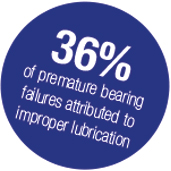 Improper lubrication accounts for around 36% of all premature bearing failures. Insufficient or too much lubrication can be equally harmful, along with incorrect selection for each application.
Improper lubrication accounts for around 36% of all premature bearing failures. Insufficient or too much lubrication can be equally harmful, along with incorrect selection for each application.
It is important to follow the bearing manufacturer’s guidelines carefully when it comes to lubrication practices. The correct quantity should be applied at the appropriate intervals, and a suitable lubricant chosen to suit the operating conditions.
It is also important to ensure that lubrication is well labelled with dates, to avoid deterioration. Closely monitor how you store, handle and inspect lubricants, considering the storage conditions and the shelf life of the lubricant.
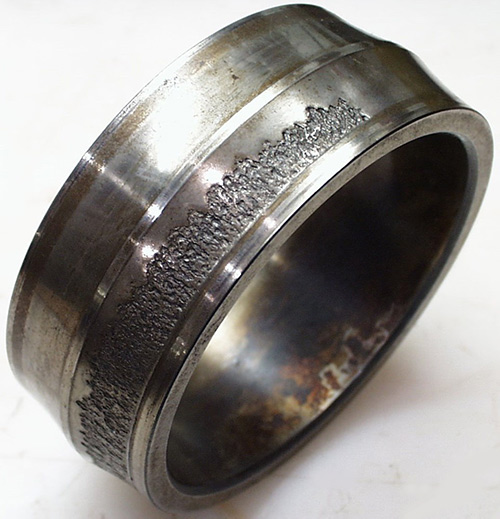 Fatigue
Fatigue
Bearing fatigue is responsible for over a third of bearing failures, with 34% of bearing failures caused by fatigue.
This is generally as a result of the bearing being overloaded, which happens when the bearing exceeds its load, speed or temperature requirements. As a result, this can cause wear and the bearing components to fracture, and subsequently fail. The greater the overload on the bearing, the greater the effect on bearing life.
Overloading can be a result of changes in production requirements, which are commonplace in today’s world, where demand is increasing but businesses are under continuous pressure to reduce overheads.
Bearings should be replaced at the first sign of fatigue, to avoid damage to surrounding equipment. Operational requirements should also be regularly reviewed to ensure that excess demand is not being placed on bearings, and bearings upgraded for increased load or speed capacity where required.
Fitting, Handling and Storage
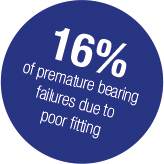 With 16% of bearing failures attributed to poor fitting, handling and storage practices, it’s easy to see the impact that improper fitting or storage can have on bearing lifespan.
With 16% of bearing failures attributed to poor fitting, handling and storage practices, it’s easy to see the impact that improper fitting or storage can have on bearing lifespan.
Bearings should be stored flat, in a cool and vibration free environment. They should be coated in preservative and wrapped in anticorrosive wrapping and should not be unwrapped until they are ready to be installed, to avoid the ingress of contamination.
When it comes to installing the bearing, it should be unwrapped in a clean environment, and fitted using specialist fitting tools such as a bearing heater or a bearing fitting kit. Methods such as naked flame or oil baths should be avoided: these methods will frequently cause bearing damage due to inconsistencies in temperature, as well as increasing the risk of worker injury due to exposure to extreme heat.
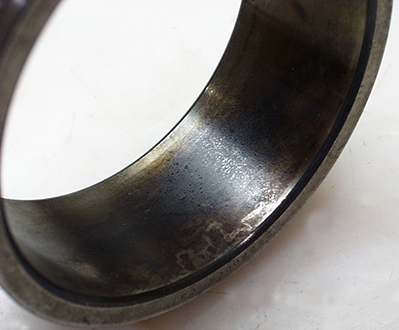 Contamination
Contamination
The final cause of bearing failure is contamination. 14% of premature bearing failures are due to contamination, and this can be avoided with effective sealing and rigorous maintenance procedures.
The most effective method of preventing bearing failure due to contamination is by selecting an optimum sealing solution, according to the operating environment and conditions that the bearing will be subjected to.
An external shield should be installed wherever possible, as a first line of defence against contamination. This will help to prevent the accumulation of dirt on the seal.
Bearings should be handled carefully when removing for inspection, to ensure that contaminants are not introduced. If the seal needs to be removed for any reason, it is recommended that the seal is replaced to avoid any damage that may have been caused by removing the seal.
Seals should be regularly checked for flexibility, hardening, cracking and contact with the shaft, as these are all features that could allow contamination to ingress into the bearing. It is also important to avoid purging excessive grease past the seal, as this has the potential to reduce the effectiveness of the seal.
Consequences Of Bearing Failure
The consequences of bearing failure can be severe, ranging from the cost of unplanned maintenance to the potential for worker injury.
Unplanned maintenance
One of the most obvious consequences of premature bearing failure is unexpected maintenance. Unless the failure happens to tie in with some scheduled downtime for maintenance and a replacement bearing is waiting in the stock cupboard, it is likely that bearing failure will require urgent shutdown of machinery for repair.
Whilst the replacement bearing is being sourced and the repair is taking place, the cost of the subsequent lost production is racking up. This causes a rush and panic which can sometimes lead to corners being cut to save time. Cutting corners has the potential to result in further problems down the line, which can be both costly and cause further downtime.
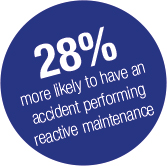 Potential for worker injury
Potential for worker injury
Unplanned maintenance increases the chance of worker injury. With workers 28% more likely to have an accident at work performing reactive maintenance over proactive maintenance, it is clear the impact that premature bearing failure can have on worker safety. It is important to take measures to ensure worker safety when performing any type of maintenance, and avoid taking any risks, even if it does mean slightly increased downtime.
Bearing removal
When preparing to remove the bearing, it is important to consider several factors.
Firstly, examine access conditions to the bearing’s location. Is it easily accessible or do measures need to be put in place to ensure worker safety when accessing the bearing? Is the surrounding environment likely to pose any safety concerns?
The time it takes to remove the bearing also needs to be considered. It is tempting to try and speed things up by using brute force to remove the bearing, to keep downtime to a minimum. However, using brute force for bearing removal increases the risk of both worker injury and damage to surrounding equipment. To minimise risk, ensure that correct procedure is followed for the removal of bearings, even if this means increased downtime.
Bearing replacement
When you need to replace a critical bearing, sourcing can be a concern. You want your bearing to be available on the shortest possible lead time, to avoid costly delays. But you don’t want to be forced to pay a huge premium for this.
Look for a supplier that carries large stocks of bearings with a fast despatch time, as well as a close relationship with a range of bearing manufacturers. This will give you the best chance of sourcing a replacement bearing on a short lead time, without having to pay a premium.
Damage to surrounding equipment
One of the costliest potential consequences of bearing failure is damage to surrounding equipment, such as shafts, bearing housings and electric motors. This can happen as a direct result of the bearing failure, or during the reactive maintenance that is performed as a result.
To limit any damage to surrounding equipment, it is important to remove the machinery from service as soon as a bearing failure is suspected. Neighbouring components should be inspected carefully for any signs of damage, and the necessary repairs undertaken before machinery re-enters service.
Impact of downtime
Downtime is often seen as the biggest issue when it comes to bearing failure. However, the consequences of downtime have the potential to cause even bigger problems.
A loss of production is a common result of downtime, which may cause the business to miss important deadlines and have the potential to effect supply contracts. A loss of production means a loss of revenue, whilst still having to pay staff, and paying for repairs to take place. A bearing failure which damages surrounding equipment and is difficult to source replacements for could have devastating consequences for a business.
How To Avoid Premature Bearing Failure
Although not every bearing failure can be prevented, it is easy to reduce the risk of occurrence if the correct measures are put in place. Furthermore, early detection of potential bearing failure can allow preventative maintenance to be undertaken before it becomes a catastrophic failure that causes downtime.
Root cause failure analysis
Whenever there is a component failure within your machinery, it is important to keep accurate records. Take note of whether a similar incident has this happened before, and if so, how often it has happened. Identify the cause of the failure, by examining the appearance of the bearing, testing the lubricant and noting the operating conditions such as load and temperature. Once a cause has been established, measures can be put in place to prevent reoccurrence.
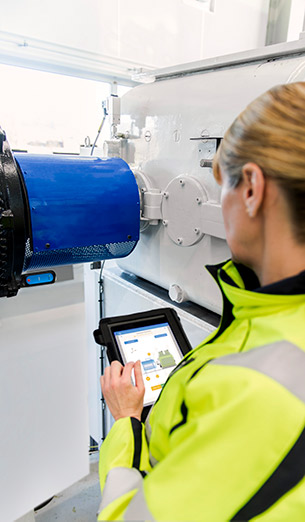 Condition monitoring
Condition monitoring
Condition monitoring is an invaluable tool for identifying bearing failure before the failure occurs. This equipment works by continuously monitoring the condition of bearings and surrounding equipment for criteria such as vibration levels and temperature. If the readings deviate from the normal operating parameters, the user is alerted. This means that maintenance can be scheduled to check the condition of the bearing, make any necessary adjustments and replace the bearing if required, before failure occurs.
Preventative maintenance
Scheduling planned maintenance rather than waiting for reactive maintenance in response to a failure, can save businesses thousands of pounds that would otherwise be lost revenue due to downtime. Preventative maintenance can be scheduled around production requirements, ensuring that disruption to the business is minimal.
